Plan your Yunnan Tour? Kunming as its capital, Yunnan Province is located in the southwestern China bordering Vietnam, Myanmar and Laos with Tibet to the west, Sichuan Province and Chongqing to the north, Guizhou Province to northeast and Guangxi Province to its east.
Yunnan is situated on a mountainous area with high elevations with a varied splendor of landscapes rich in plants and animal species. About half of the ethnic minority people in China reside here with 26 different ethnic minorities in Yunnan.
If you are looking for the top things to do in Yunnan, so here is the list of the Top 10 Places in Yunnan.
1. Yuanyang Rice Terraces 元阳梯田
Yuanyang County is located in Honghe Hani and Yi Autonomous Prefecture in the south of Yunnan Province. It is a Hani minority settlement with vast rice-terraced mountains. Part of the area now forms the 45th World Heritage Site in China.
Yuanyang is dissected into two parts – New Town and Old Town which are 30 km apart. Most people come to the old town known as Xinjie Town as the jumping off point to visit the nearby rice terraces.
The terraced paddy fields on the slopes are the collective masterpieces of labor by Hani minority people in their successive generations. Picturesque hilltop villages, rice fields bouncing off mesmerizing colors at sunrise and sunset are your reason to make efforts to come to the Hani’s place.
Visiting Time: suggested 2 Days
Entrance Fee: RMB 100
Location: 320 km south of Kunming and 120 km south of Jianshui
Opening Hours: all day
Best Time to Visit: Winter
How to Get There
Daily buses from Kunming and Jianshui
2. Tiger Leaping Gorge 虎跳峡
Tiger Leaping Gorge, located 60 kilometers north of Lijiang City, is one of the deepest gorges on the planet, and it has the best hiking trails in Yunnan. Tiger Leaping Gorge is sandwiched by Jade Dragon Snow Mountain to the east and Haba Mountain with plenty of trekking trails.
The 17km-long gorge is divided into three segments with an aggregate fall of 210 meters. At the opening of the gorge, which is also the mouth of the Jinsha River, a Herculean pebble, about 30 meters wide, seems to be stranded amidst the billowing waves. Spring is the best time as the river turbulence is at its peak.
Visiting Time: suggested 3-4 hours, or for a longer periods of 2-3 Days
Entrance Fee: CNY 65
Opening Hours: 09:00-16:30
How to get there: There are no buses can reach the Tiger Leaping Gorge directly, you can take the Tourist Bus to the Tiger Leaping Gorge.
Best Time to Visit: spring and autumn
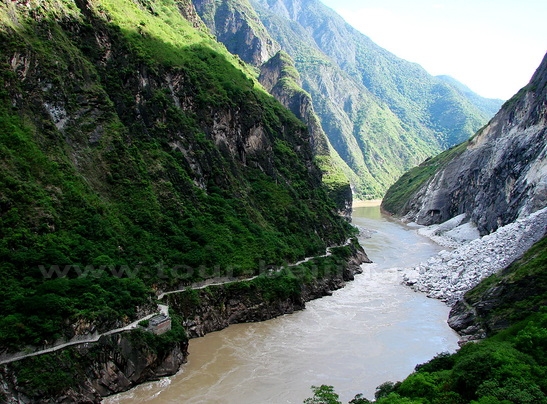
3. Shangri-la 香格里拉
Shangri-La, previously Zhongdian, an ethnic Tibetan township and county set high in Yunnan’s northwestern mountains. Shangri-la is located 180 km northwest of Lijiang and 620 km of Kunming.
Shangri-la is home to the magnificent Tibetan monasteries in Yunnan and the most rewarding one known as Ganden Sumtseling Gompa with great charm. It is a over 300-year Tibetan monastery with about 600 monks.
Strolling around the old town of Shangri-la is one of your reasons to come here. The old town is known as “Square Street” which has a web of cobbled laid-back streets and lanes, and old-time buildings. People also see other attractions in the old town, white pagodas everywhere.
Visiting Time: suggested 1-2 day
Best time to go: spring and autumn
How to get there:
Take flights from Kunming or Lijiang; Daily buses from Deqin and Lijiang
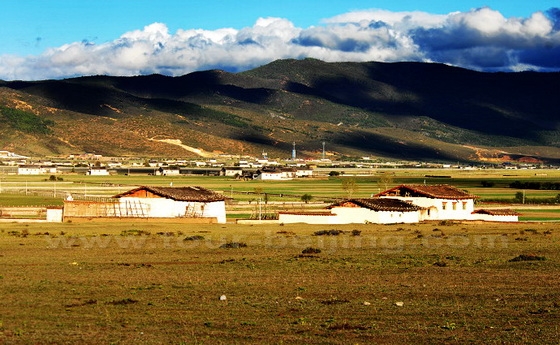
4. Deqin 德钦
Deqin Town is the seat of the Deqin Tibetan autonomous prefecture in northwestern Yunnan. Deqin Town is located 180 km to the northeast of Shangri-la. Deqin is situated almost embraced by the one of the most imposing mountains in China – Meili Snow Mountain also known as Kawa Karpo at 6740 meters, the highest peak straddling Yunnan and Tibet.
Deqin town is the last outpost of Yunnan before entering Tibet. Seeing the magical Meili Mountain at sunrise and sunset is the main reason for people to come here. In addition, there are over 10 Tibetan temples in Deqin and Feilai Temple is worth a visit. Just located 10 km southwest of Deqin, Feilai Temple is devoted to the spirit of Meili Snow Mountain.
Visiting Time: suggested 1-2 day
Best time to go: Winter and spring
How to get there:
Daily buses from Shangri-la
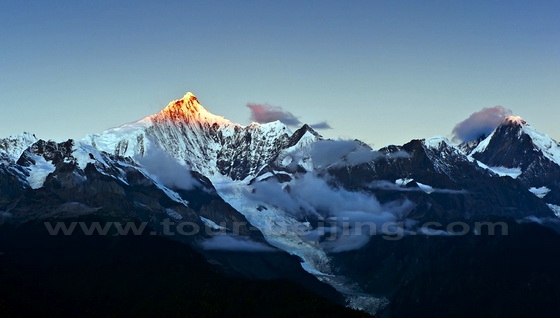
5. Shaxi 沙溪
Shaxi Old Town is located in Jianchuan County between Dali and Lijiang, 120 km northwest of Dali and 100 km southwest of Lijiang. It is a tiny hamlet, more rustic and tranquil than the commercialized Lijiang Old Town.
Shaxi Old Town was the essential station for the old Tea-Horse-Roads between Lijiang and Dali extending from Yunnan to India. Its remoteness has kept most of the old buildings intact – the old-time wooden houses, courtyards and winding streets. It is a wonderful laid-back place.
Its highlight is Sideng Jie, a square street, the soul and focus of Shaxi Old Town. The Sideng Jie Square Street comprises temples, fairs and markets, the stage, stores and inns, old trees, old lanes and spacious cobbled streets, oft-lauded as ” the only remaining old town along the Tea-Horse-Roads.
Visiting Time: suggested 6-8 hours
Entrance Fee: Free
Opening Hours: all day
Best time to go: Feb – June and Sept – Nov ( non-rainy season)
How to get there:
Daily buses to Shaxi from Lijiang, Dali, Shangri-la andKunming
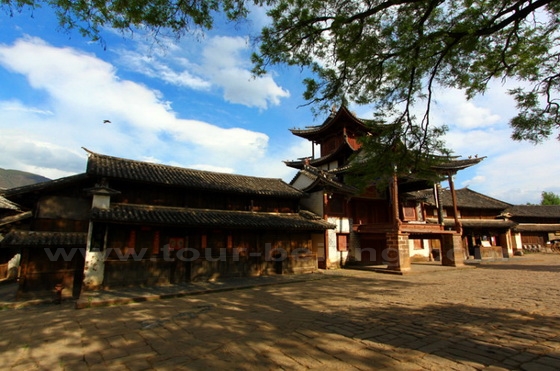
6. Bingzhongluo 丙中洛
Bingzhongluo Township is located in Nu Jiang River Valley, within the administration of Nu Jiang Lisu Autonomous Prefecture, 329 km north of Liuku and 43 km north of Gongshan, close to Tibet and Myanmar.
Bingzhongluo is a great springboard for hikes into the surrounding mountains and valleys. Nu Jiang River passes the Ridan Village of Bingzhongluo Township and forms a half circle bend, oft-lauded as ” The First Bend of Nu Jiang River”. At the middle of the bend there is a village called “Kantong Village” with a sea level of 1710 meters, 500 meters higher than Nu Jiang River itself, forming a plain peninsula surrounded by water on its three sides.
The main reason to come to Bingzhongluo is to visit the friendly old-time villages and the magical Nu Jiang River First Bend. Bingzhongluo still has the well preserved 70 km Tea-horse road leading to Tibet.
Visiting Time: suggested 1-2 day
Entrance Fee: RMB 100
Location: 329 north of Liuku and 43 km north of Gongshan
Opening Hours: all day
Best Time to Visit: Spring and Autumn
How to Get There:
Going to Bingzhongluo is a bit tricky. Daily buses from Gongshan and Liuku
Note: If you want to have a photo opportunity of “The First Bend”, you’d better ascend the Gongdangshan before 13:00.
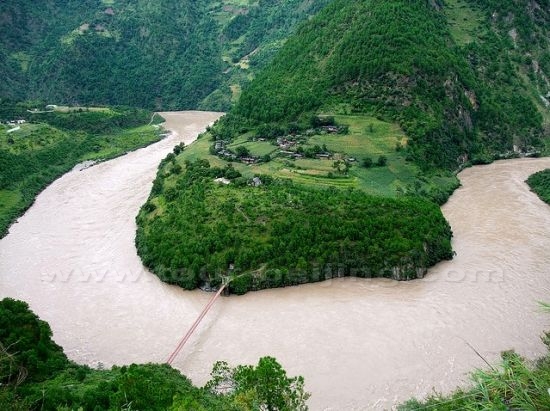
7. Dali 大理
Dali Old Town has a rather glorious history which could be traced back to 738. In 738 the Nanzhao Kingdom was established with Dali as its capital. After several decades of chaos the Kingdom of Dali emerged in 937.
The Kingdom of Dali established by Duan Siping in 937 was controlled by the Duan clan and survived until conquered by the Mongols in the 12th century. 1856-1872 Dali was the headquarters of the Panthay Rebellion led by Du Wenxiu.
The old Dali City was rebuilt in the early 1400s by the Ming Dynasty. What you see in Dali Old Town today is the rebuilt Ming town. Since then, the fortunes of Dali have declined and its importance as a cultural and economic centre in the Yunnan area have been overtaken by Kunming.
Now Dali City is mainly populated by the ethnic groups such as Bai, Li, Dai, Zhuang, Miao, Hui, Wa, Naxi, and Han Nationalities with Bai nationality taking the majority.
Dali Old Town is sandwiched by Erhai Lake on the east and Changshan Mountain on the west. The old town is a laid-back place with a artery-like web of cobbled streets and lanes. Tourism is growing here, the old town still keeps its original outlook, more rustic and tranquil than the touristified neighbor – Lijiang Old Town.
Loafing around Dali Old Town and its nearby old time townships, villages and markets is an unforgettable experience in Yunnan: boating in Erhai Lake, ascending Cangshan Mountain, visiting the iconic Three Pagodas, shopping at local markets ( batik ).
Visiting Time: suggested 1-2 day
Old Town Entrance Fee: free
Location: 400 km west of Kunming and 248 km south of Lijiang.
Opening Hours: all day
Best Time to Visit: Spring and Autumn
How to Get There
Going to Dali is a breeze. You may take flights and trains from Kunming. Buses going all the major cities in Yunnan.
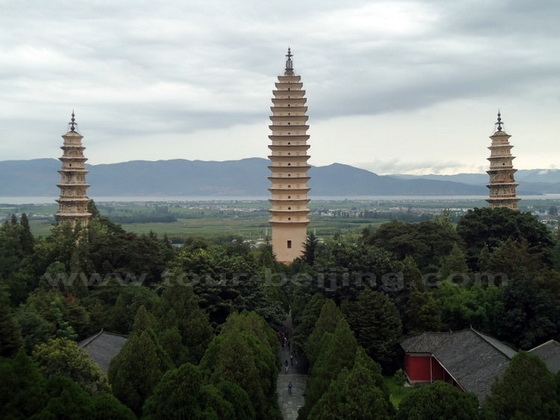
8. Jianshui 建水
Jianshui County is under the jurisdiction of Honghe Hani and Yi Autonomous Prefecture in the south of Yunnan Province, 229 km south of Kunming and 140 km north of Yuanyang.
Since the Yuan Dynasty, Jianshui was the political, cultural and communication center in south Yunnan. Jianshui got the name because the basin was flooded every summer and autumn. In Mandarin, it was known as Jianshui. From the establishment of the city in the Tang Dynasty (618-907AD) to now, Jianshui County has had a history of over 1,180 years. It is one of the areas that have been deeply influenced by the Central Plains culture.
The long history of Jianshui has produced its splendid culture. Due to its early development, Jianshui produced thousands of scholars. Moreover, with the influence of the grand Jianshui Confucius Temple, it was rightfully called “the Cultural City” since the Ming Dynasty (1368-1644).
The reason to come to Jianshui is to visit the mesmerizing town of old time buildings, a huge confucius Temple, a cave peppered with swallows, and the yummy local cuisines rarely seen in other places in Yunnan. Other attractions include Zhu Family Garden, Chaoyang Gate and Zhilin Temple.
Visiting Time: suggested 1 day
Old Town Entrance Fee: free
Location: 229 km south of Kunming and 140 km north of Yuanyang
Opening Hours: all day
Best Time to Visit: March and April; September and October
How to Get There
Going to Dali is quite convenient. You may take the daily buses from Kunming
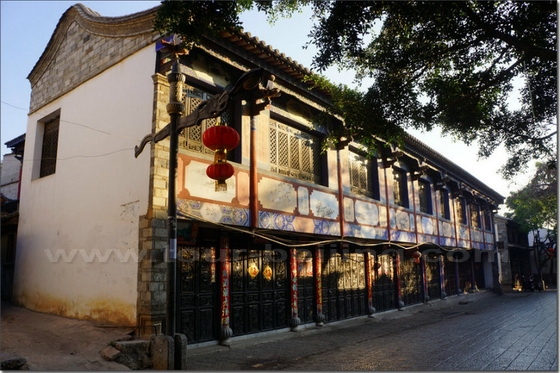
.9. Lugu Lake 泸沽湖
Lugu Lake, which is located in the North West Yunnan plateau, is home to the Mosu minority(China’s only matriachal society), and what has to be some of China’s most spectacular scenery.
Lugu Lake is a natural lake in the Hengduan Mountain System, and has a horseshoe shape. It is called the “mother lake” by the Mosuo people. Lugu Lake is 48.5 square kilometers in area and about 93 meters deep at its deepest point. Most people go to Lugu Lake from Lijiang. There is a six or eight hour bus ride up and down mountains on narrow dirt roads.
Entrance Fee: CNY 80
Opening Hours: 08:00-18:00
How to get there: take shuttle bus at Old Town to the Lugu Lake which will take you aroud CNY 100
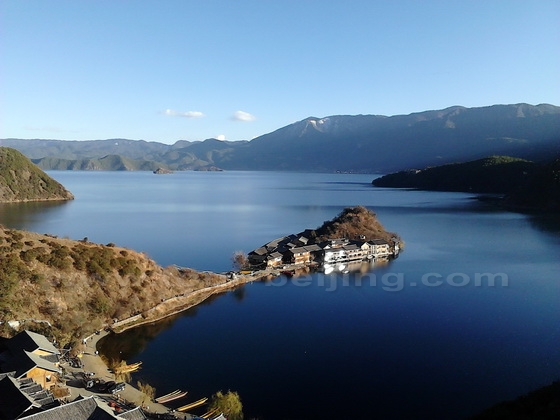
10. Xishuangbanna 西双版纳
With its capital city of Jinghong, Xishuangbanna is a Dai minority autonomous prefecture. Xishuangbanna, popularly called Banna, is located in the southern tip of China, bordering Laos, Myanmar, and close to Vietnam and Thailand with a 996 km borderline.
Xishuangbannan, literally “Ideal and Magical Paradise” in Thai, is famous for its tropical rain forests and ethnic minority folk customs, one of China’s tropical tourist area. Bannan is a varied land with rich plants and animal species.
The reason to come to Xishuangbannan is to bath in sunshine, experience the minority folk customs (water-splash festival), and visiting tropical botanical gardens.
Visiting Time: suggested 2-4 day
Location: southern tip of Yunnan and China
Best Time to Visit: October – June
How to Get There
Air: Xishuangbanna Gasa Airport is the second largest airport in Yunnan, located just five kilometers from the downtown. Flights to Kunming, Shanghai, Chengdu and other major cities in China run regularly. There is one weekly international flight to Luang Prabang.
Waterway: There are international waterage line to Laos.
Highway: The speedway from Jinghong to Menghai, Mengla, and Kunming.
The city has the largest public transportation center in Xishuangbanna and connects travelers to nearby cities, towns and villages.
Any questions, just drop a line.





